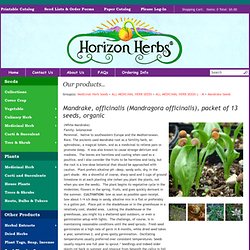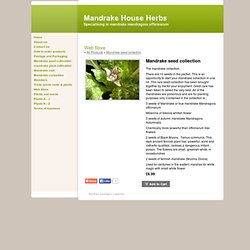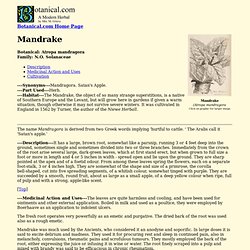

Mandragora. Mandrake, officinalis seeds, organic, in stock! (White Mandrake) Family: Solanaceae Perennial.

Native to southeastern Europe and the Mediterranean. Rare. The ancients used Mandrake root as a fertility herb, an aphrodisiac, a magical totem, and as a medicinal to relieve pain or promote sleep. . * We ran four concurrent germ tests with the fresh and newly-dried seed from our 2005 harvest. Web store - Mandrake House Herbs. The mandrake collection.

There are 10 seeds in the packet .This is an opportunity to start your mandrake collection in one hit .This rare seed collection has been brought together by me for your enjoyment .Great care has been taken to select the very best .All of the mandrakes are poisonous and are for planting purposes only Contained in the collection is ; World Seed Supply’s Mandrake Germination Guide « worldseedsupply.org. Mandrake (Mandragora Officinarum) is a member of the nightshade family most notable for its use in witchcraft and its mention in the Harry Potter novel series.

Mandrake has a rich folklore that dates back to biblical times. Like other nightshades such as belladonna, brugmansia, datura and henbane, mandrake contains highly toxic tropane alkaloids that can cause complete delirium, vomiting and death. Mandrake is an interesting plant that enjoys the cold weather and forms a huge taproot. Fresh roots sell for impressive amounts of money, although dried roots are fairly inexpensive. Mandrake seeds have a reputation for being stubborn germinators. After about a month in the fridge, move your mandrake seeds to a warmer location and plant in a loose, fertile well-draining soil. Another method for triggering temperature responsive germination in seeds is what we call winter sowing.
You will find that mandrake generally does better in the cool or at least mild weather. Mandrake. Botanical.com Home Page Botanical: Atropa mandragora Family: N.O.

Solanaceae ---Synonyms---Mandragora. Satan's Apple. ---Part Used---Herb. The name Mandragora is derived from two Greek words implying 'hurtful to cattle. ' The Arabs call it 'Satan's apple.' ---Description---It has a large, brown root, somewhat like a parsnip, running 3 or 4 feet deep into the ground, sometimes single and sometimes divided into two or three branches. [Top] ---Medicinal Action and Uses---The leaves are quite harmless and cooling, and have been used for ointments and other external application. The fresh root operates very powerfully as an emetic and purgative. Mandrake was much used by the Ancients, who considered it an anodyne and soporific. Mandrake was used in Pliny's days as an anaesthetic for operations, a piece of the root being given to the patient to chew before undergoing the operation.
Mandrake, The Witches' Herb. Mandrake's ruling planet is Mercury, and Earth is sometimes mentioned in association with it.

It is sacred to Hecate, and is also associated with Diana, Hathor, Aphrodite, Circe, and the Alrauna Maiden (A legendary sorceress). I've also seen it mentioned with Saturn as a ruling deity. If you can't get the real mandrake, Mandragora officianalis, then the Americal herb mayapple, Podophyllum peltaltum, can be used as a substitute. It is not related to the real mandrake. Sacred Earth - Sacred Plants: Mandrake (Mandragora officinalis) © Kat Morgenstern, February 2002 There are 6 species in this genus, the most common of which is Mandragora officinarum. The perennial plants form a leaf-rosette with no stalk. The leaves can grow up to a foot in size and are between 4 - 5 inches wide with a sharply pointed apex. When they first emerge they stand erect, but gradually flatten out. The star like flowers are five pointed and somewhat bell-shaped. Mandrake originates in the eastern Mediterranean region and is distributed throughout southern Europe, the Middle East and northern Africa, where it grows in waste places and abandoned fields in sandy and rocky, well draining soil.
Once shrouded in much mystery and lore, Mandrake, the most important magical plant of the Middle Ages, today has been all but forgotten. Mandrake was also known to have narcotic properties and in Antiquity was often used as an anaesthetic for surgical procedures. Apuleius thought it an effective remedy to counteract possession by evil spirits. Home - Mandrake House Herbs. How to Grow Mandragora Officinarum. Overview Mandragora officinarum, also known as mandrake, is a perennial herb that produces large, dark green leaves that sprout immediately from the root.

It produces bright, ornamental flowers that are usually pink or purple in color, and blooms during late spring and early summer. Mandragora officinarum requires regular maintenance to keep healthy, but can thrive in most temperate climates. Step 1 Start Mandragora officinarum seeds in a small planter in a greenhouse during spring. Step 2 Remove Mandragora officinarum from the container and plant immediately in its permanent location just after the final frost of winter. Step 3 Water thoroughly just after planting to compact the soil around the roots. Step 4 Feed Mandragora officinarum once every 2 months using a low nitrogen 0-10-10 fertilizer. Step 5 Spread a 2-inch layer of mulch around the soil surrounding Mandragora officinarum plants to deter the growth of weeds and to help conserve moisture.